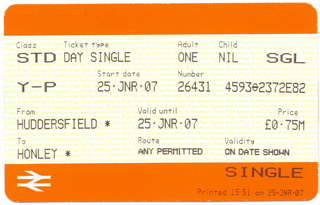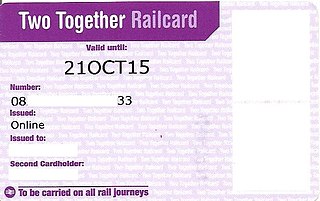
Trenitalia c2c Limited, trading as c2c, is an English train operating company owned by Trenitalia that operates the Essex Thameside railway franchise. It manages 25 stations and its trains call at 28. c2c provides commuter services from its London terminus Fenchurch Street and from Liverpool Street to east London and parts of Essex along the London, Tilbury and Southend line.

Barking is an interchange station serving the town of Barking, east London. It is served by London Underground, London Overground and National Rail main line services. It is located on Station Parade, in the town centre.

Bat & Ball railway station is on Bat & Ball Road in the suburban town of Sevenoaks in Kent, England. The station is managed by Southeastern although all trains that serve the station are Thameslink. It is 25 miles 51 chains (41.3 km) from London Victoria, although all northbound trains run to London Blackfriars.

The National Location Code (NLC) is a four-digit number allocated to every railway station and ticket issuing point in Great Britain for use with the ticketing system on the British railway network. They are used in the issue of tickets and for accounting purposes. They are a subset of the NLCs created by British Rail, which are based on four "main" digits plus two supplementary digits.

The Shere SMART is a desktop-based railway ticket issuing system, developed by the Guildford-based company Shere Ltd, utilising Newbury Data ND4020 ticket printer, first introduced in Britain in 2003. Since the first trial installation of the system in the ticket office at London Bridge station, approximately 300 terminals have been installed at stations on the Southern and former Thameslink networks.

Tickets issued from British Rail's APTIS system had a considerable amount of detail, presented in a consistent, standard format. The design for all tickets was created by Colin Goodall. This format has formed the basis for all subsequent ticket issuing systems introduced on the railway network – ticket-office based, self-service and conductor-operated machines alike.
There is no single 'discount railcard' available on the UK railway network. In addition to the large number and variety of short-term or localised promotional fares that have been available to passengers on the British railway network in recent decades, there are many permanent concessionary fare schemes available to passengers. Some of these take the form of Railcards, which can be purchased by people who qualify according to the conditions, and which give discounts for all journeys over a period; other concessions are available for individual journeys. In all cases, details of the type of concession will be printed on the passenger's travel ticket, to distinguish reduced-rate tickets from those sold at the standard full fare.
Public transport ticketing in New South Wales, Australia operated using magnetic-stripe technology between 1989 and 2016. This ticketing system, known variously as the Automated fare collection system, STATS and, from 2010, MyZone, was progressively replaced by a contactless smart card called Opal between 2012 and 2016.

Ascom B8050, usually known by the name QuickFare, is an early example of a passenger-operated railway ticket issuing system, consisting of a series of broadly identical machines installed at British railway stations from 1989 onwards. The machines allow passengers to buy the most popular types of ticket themselves, without having to go to a booking office, and are therefore useful at unstaffed, partly staffed or busy stations. All QuickFare machines have been replaced by more modern technology.

The Atos Worldline FASTticket system is a passenger-operated, self-service railway ticket issuing system, developed by the Guildford-based company Shere Ltd and first introduced on a trial basis in Britain in 1996, shortly after privatisation. It has been developed and upgraded consistently since then, and is now used by seven Train Operating Companies (TOCs) as their primary self-service ticket issuing system. Other TOCs have FASTticket machines at some of their stations, sometimes supplementing other systems.

The 16–25 Railcard is an annual card giving discounts on certain types of railway ticket in Britain. It is available to anybody aged between 16 and 25 (inclusive), and certain mature students aged 26 and above, and is currently priced at £30.00. There is no restriction on the number of times the Railcard can be used to purchase discounted tickets during the period of its validity, and there are no geographical restrictions on its use.

The Edmondson railway ticket was a system for recording the payment of railway fares and accounting for the revenue raised, introduced in the 1840s. It is named after its inventor, Thomas Edmondson, a trained cabinet maker, who became a station master on the Newcastle and Carlisle Railway in England.

Avantix Mobile ("AVB") is a portable railway ticket issuing system used across the British railway network from 2001 to 2017.
PORTIS and latterly SPORTIS were portable ticket issuing systems used on Rail transport in Great Britain from 1982 until 2006. The system was also formerly used by Northern Ireland Railways for the issue of all tickets, including at railway station booking offices.
Cubic FasTIS is the latest TIS introduced to the UK National Rail Retailers. The prototype was piloted at Chiltern Railways High Wycombe station from April 2005, the second pilot machine was deployed at Banbury station. Following successful piloting, both Northern Rail and Chiltern Railways selected FasTIS to replace their APTIS fleet.

The Senior Railcard is an annual card available to people aged 60 and over, which gives discounts on certain types of railway ticket in Britain. The Railcard has existed in various forms since 1975; the current version is priced at £30.00 and is valid for one year, with a 3-year card available for £70. It is one of a wide variety of discounted and concessionary fare schemes available on Britain's railway network.
The Family and Friends Railcard is an annual rail travel discount card for use in Great Britain by adults travelling with at least one child. Cards valid for either one or three years can be purchased at a cost of £30 for one year or £70 for three. It is one of the discounted and concessionary fare schemes available on Britain's railway network to people who either belong to particular groups or who are willing to buy tickets ahead of the date of travel. Before 18 May 2008 it was known as the Family Railcard, but the name was changed to reflect the fact that discounted travel is not restricted to adults and children who are related.

Avantix B8070, more commonly known as Avantix MultiTicket was a passenger-operated railway ticket issuing system, installed at British railway stations from 1999 onwards. The machines were available as upgrades to the Ascom B8050 Quickfare or as new build.

In 2014, a new design was introduced for train tickets issued on the National Rail network in Great Britain. The pre-2014 design was similar to the APTIS design introduced in 1986 by British Rail.

The Two Together Railcard is a scheme which gives discounts on certain types of railway ticket in Britain. Launched nationally in 2014 after a successful trial in 2011–12, it was the first new Railcard scheme since the 1980s. It is available to any two named individuals aged 16 or over and is priced at £30.00. There is no restriction on the number of times the Railcard can be used to purchase discounted tickets during the period of its validity, and there are no geographical restrictions on its use.















